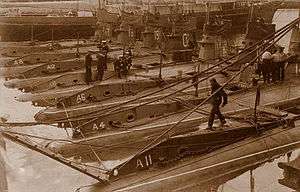HMS A11
 A group of A-class submarines | |
| History | |
|---|---|
| Name: | A11 |
| Builder: | Vickers, Sons & Maxim Ltd. Barrow-in-Furness, England |
| Launched: | 8 March 1905 |
| Commissioned: | 11 July 1905 |
| Fate: | Scrapped, May 1920 |
| General characteristics | |
| Class and type: | A-class submarine |
| Displacement: |
|
| Length: | 105 ft (32.0 m) |
| Beam: | 12 ft 9 in (3.9 m) |
| Draught: | 10 ft 8 in (3.3 m) |
| Installed power: |
|
| Propulsion: |
|
| Speed: |
|
| Range: | 500 nautical miles (930 km; 580 mi) at 10 kn (19 km/h; 12 mph) surfaced |
| Complement: | 2 officers and 9 ratings |
| Armament: | 2 × 18-inch (45 cm) torpedo tubes |
HMS A11 was an A-class submarine built for the Royal Navy in the first decade of the 20th century. After surviving World War I, she was sold for scrap in 1920.
Design and description
A11 was a member of the first British class of submarines, although slightly larger, faster and more heavily armed than the lead ship, HMS A1. The submarine had a length of 105 feet 1 inch (32.0 m) overall, a beam of 12 feet 9 inches (3.9 m) and a mean draft of 10 feet 8 inches (3.3 m). They displaced 190 long tons (190 t) on the surface and 206 long tons (209 t) submerged. The A-class submarines had a crew of 2 officers and 11 ratings.[1]
For surface running, the boats were powered by a single 16-cylinder 600-brake-horsepower (447 kW) Wolseley petrol engine that drove one propeller shaft. When submerged the propeller was driven by a 150-horsepower (112 kW) electric motor. They could reach 11 knots (20 km/h; 13 mph) on the surface and 6 knots (11 km/h; 6.9 mph) underwater.[1] On the surface, A11 had a range of 500 nautical miles (930 km; 580 mi) at 10 knots (19 km/h; 12 mph); submerged the boat had a range of 30 nautical miles (56 km; 35 mi) at 5 knots (9.3 km/h; 5.8 mph).[2]
The boats were armed with two 18-inch (45 cm) torpedo tubes in the bow. They could carry a pair of reload torpedoes, but generally did not as doing so that they had to compensate for their weight by removing an equal weight of fuel.[3]
Construction and career
A11 was ordered as part of the 1903–04 Naval Programme from Vickers.[4] She was laid down at their shipyard in Barrow-in-Furness in 1903, launched on 8 March 1905 and completed on 11 July 1905.[2]
On 7 September 1910 A11 collided with a barge when leaving Portsmouth Harbour. The barge was sunk, although her two crew were rescued, and A11's bow was slightly damaged.[5]
Notes
References
- Akermann, Paul (2002). Encyclopaedia of British Submarines 1901–1955 (reprint of the 1989 ed.). Penzance, Cornwall: Periscope Publishing. ISBN 1-904381-05-7.
- Colledge, J. J.; Warlow, Ben (2006) [1969]. Ships of the Royal Navy: The Complete Record of all Fighting Ships of the Royal Navy (Rev. ed.). London: Chatham Publishing. ISBN 978-1-86176-281-8. OCLC 67375475.
- Gardiner, Robert & Gray, Randal, eds. (1984). Conway's All the World's Fighting Ships: 1906–1921. Annapolis, Maryland: Naval Institute Press. ISBN 0-85177-245-5.
- Harrison, A. N. (January 1979). "The Development of HM Submarines From Holland No. 1 (1901) to Porpoise (1930) (BR3043)". Submariners Association: Barrow in Furness Branch. Archived from the original on 19 May 2015. Retrieved 19 August 2015.